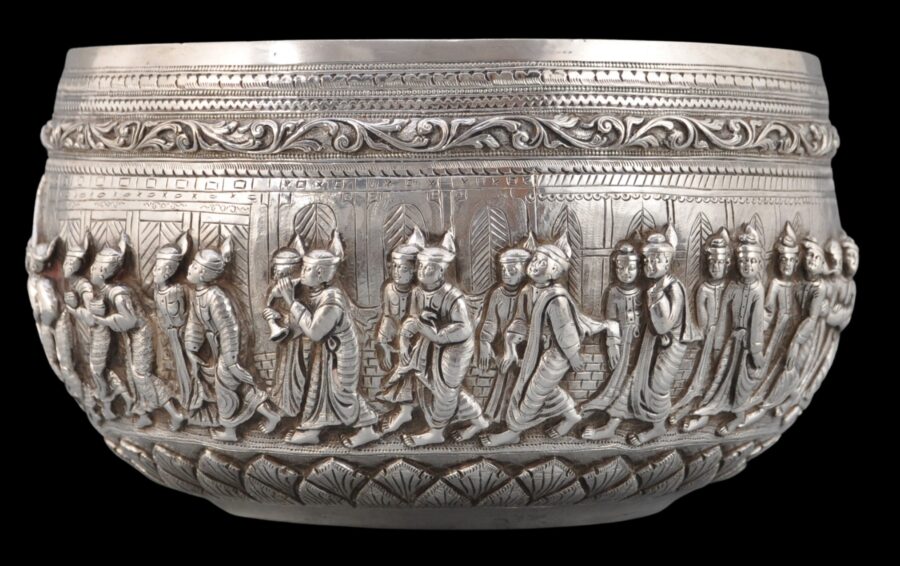This fine Burmese silver bowl is repoussed all the way around with one single processional scene of no less than 34 participants.
Among the items carried in the procession are two triangular, flat, brass gongs known as kyi-zi which are unique to Burma. One is held aloft by a single participant, and another is suspended from a horizontal pole between the shoulders of two procession members. The kyi-zi are sounded whenever a person makes a donation to a pagoda. Also being carried in the procession and suspended from poles is a lacquer food container or ok-kwet, and an ornament offering container daung-baung.
It is a dynamic scene – another participant is smoking a pipe; several carry umbrellas, others carry flags and others still carry standards; two carry lacquer alms bowls or thabeik; and one blows on a trumpet-like instrument.
The upper border comprises a raised, elaborate dha-zin-gwei or stylised orchid motif border.
The lower frieze comprises a fine border of acanthus leaf motifs in relief.
The base is engraved with a flower motif.
Bowls such as these had no ceremonial or religious use; they are purely decorative. Their shape is supposedly based on Burmese monks’ black lacquer begging or alms bowls (one of the eight parikkharas or possessions allowed a monk). In turn, such bowls are based on a bowl that the Buddha himself is said to have used. A begging bowl was known as a thabeik. Silver bowls such as this example are not themselves correctly called a thabeik however. Although the shape of such silver bowls is based on the monk’s begging bowl, ironically, Burmese monks are prohibited from touching gold or silver. Accordingly, Burmese silversmiths generally did not use their skills on religious objects, unlike silversmiths in other Buddhist lands such as Tibet or Sri Lanka. Silver items might have been presented to a monastery or temple however, but these were to honour the Buddha and the donation was to earn merit. Such donations cannot be seen as a gift for monks however.
The rim of the bowl here is punched with a tiny oval assay mark with a swan motif. This mark is for silver articles imported into France and was used from mid-1864.
Many such bowls do have small gaps and holes in the side from the high relief of the repousse work. This inside cavities of this example however have been partly filled with plaster to plug any such holes.
Overall, this bowl is a fine example, and with a particularly unusual scene.
References
Fraser-Lu, S., Silverware of South-East Asia, Oxford University Press, 1989.
Fraser-Lu, S., Burmese Crafts: Past and Present, Oxford University Press, 1994.
Green, A., Burmese Silver from the Colonial Period, Ad Illisvm, 2022.
Owens, D.C., Burmese Silver Art: Masterpieces Illuminating Buddhist, Hindu and Mythological Stories of Purpose and Wisdom, Marshall Cavendish Editions, 2020.
Tilly, H.L., The Silverwork of Burma (with Photographs by P. Klier), The Superintendent, Government Printing, 1902.
Tilly, H.L., Modern Burmese Silverwork (with Photographs by P. Klier), The Superintendent, Government Printing, 1904.















